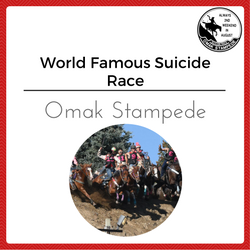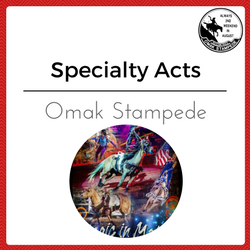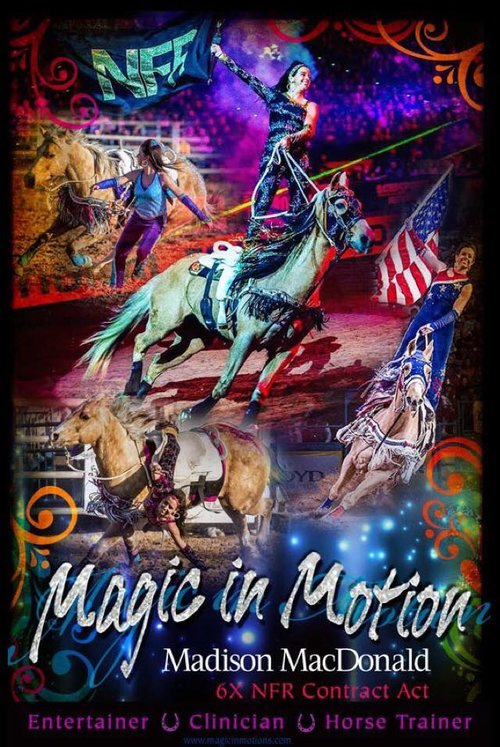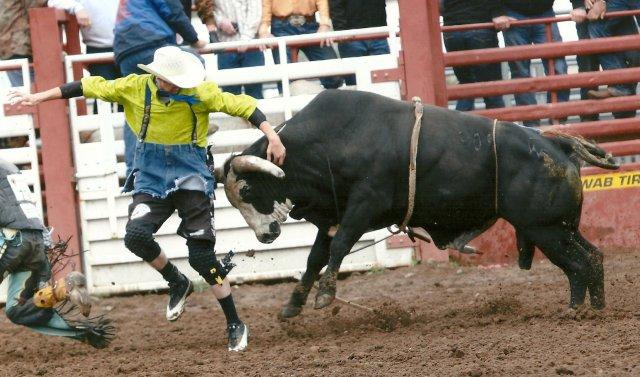Events Overview
Annual Omak Stampede
"ALWAYS THE 2ND WEEKEND IN AUGUST!"
We would like you to join us for a weekend of western entertainment that will be one of your fondest memories. From the Thursday morning ride-in to the Sunday running of the World Famous Suicide Race, you will enjoy an action packed weekend to include Davis Shows Carnival, Wrangler Kids Night, Indian Encampment & Pow Wow, Western & Native Art Show, Rodeo Dances and Vendor Row, Omak Stampede “Company Store”. As well, Omak Stampede continues to support the Tough Enough to Wear Pink Campaign.
Omak Stampede Schedule & Events
Schedule
86th Annual Omak Stampede
WEDNESDAY, AUGUST 7TH
5:00-11:00pm: Davis Shows Carnival Opens Encampment Opens Western and Native Art Show Kick Off
THURSDAY, AUGUST 8TH
8:00am: Ride-In Sponsored by the Okanogan Team Penner’s Association
10:00am-7:00pm: Western & Native Art Show – Omak Elks Lodge
1:00pm-6:00pm Cowboys and Indians Invitational Art Show Artist Reception- Rockwall Cellars
4:00pm: Wrangler Kids Night
5:00-11:00pm: Davis Shows Carnival
5:30-10:00pm Stampede Outreach
6:00pm: Omak Stampede Indian Encampment Official Opening Ceremonies
7:00pm: Omak Stampede PRCA Rodeo & World Famous Suicide Race
FRIDAY, AUGUST 9TH
All Day: Indian Encampment
9:00am: Slack – Timed Events
10:00am – 7:00pm: Western & Native Art Show – Omak Elks Lodge
4:00pm – Midnight: Davis Shows Carnival
5:30 – 10:00pm Stampede Outreach
7:00pm: Omak Stampede PRCA Rodeo & World Famous Suicide Race
SATURDAY, AUGUST 10TH
All Day: Indian Encampment
10:00am-7:00pm: Western & Native Art Show
2:30pm-5pm Reception & Live Auction – Omak Elks Lodge
11:00am-Midnight: Davis Shows Carnival
5:00-10:00pm Stampede Outreach
7:00pm: Omak Stampede PRCA Rodeo & World Famous Suicide Race
Followed by Dance at the Stampede Grounds
SUNDAY, AUGUST 11TH
All Day: Indian Encampment 8:30am: Western Church Service at the Stampede Outreach Stage
10:00am: Stampede Grand Parade – Downtown Omak
9:00-2:00pm: Western & Native Art Show –Omak Elks Lodge
11:00am: Davis Shows Carnival
2:00pm: Omak Stampede PRCA Rodeo & World Famous Suicide Race
PRCA Rodeo
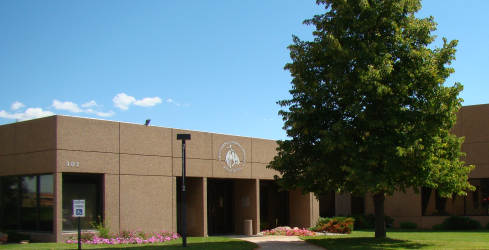
“The PRCA, headquartered in Colorado Springs, Colo., is the largest and oldest professional rodeo-sanctioning body in the world. The recognized leader in ProRodeo, the PRCA is committed to maintaining the highest standards. The PRCA, a membership-based organization, sanctions approximately 600 rodeos annually, and there are more than 30 million fans in the U.S. Unlike most other professional sports, where contestants are paid salaries regardless of how well they do at a particular competition, cowboys generally pay to enter each rodeo. If they place high enough to win money, they probably make a profit, but if they don’t, they’ve actually lost their entry fee and any travel expenses, so every entry is a gamble pitting the chance for loss and physical injury against the chance for financial windfalls and athletic glory. Also unlike most sanctioned professional sports, the hundreds of “playing fields” – rodeo arenas – of PRCA-sanctioned rodeos vary widely by locale. The size, shape, perimeter and roof/open top of an arena, as well as the chute configuration, greatly affect times for timed events and, to a lesser extent, scores for roughstock events. The differences are so significant that some timed-event cowboys own different horses for different types of arenas. For that reason, the most fair way to measure cowboys’ success in competition across the varied settings is by earnings. The total payout at PRCA rodeos in 2010 was $39,870,303 – a $2 million increase from 2009.” –PRCA Rodeo Website
Check here the for most up-to-date Standings: PRCA Standings

“The Women’s Professional Rodeo Association was formed in 1948 when thirty-eight cowgirls came together in San Angelo, Texas to create an organization dedicated to the promotion and advancement of women in the sport of rodeo. The earliest pioneers of the Girl’s Rodeo Association (GRA) were ropers, bronc riders, and barrel racers. They were fed up with a system which did not grant them competitive opportunities in the arena and, when it did, operated under unfair conditions.The GRA began with 74 original members with 60 approved contests and total payout of $29,000. In 1981 the GRA changed its name to the Women’s Professional Rodeo Association. It is the oldest women’s sports association in the country and the only one governed entirely by women.” – WPRA Rodeo Website
Check here for the most up-to-date Standings: WPRA Standings
Official Events

Bull Riding
In what is hoped to be an eight-second ride, the rider holds a flat-braided rope in his glove hand. As he settles onto his bull in the chute, he pulls the rope’s tail through a loop and wraps the rope around his riding hand, at times weaving it through his fingers for better grip. Each bull has a different style of bucking; some spin, others circle, others throw in jumps or kicks, and others move sideways in mid-air. As the cowboy waves his free hand to counter the bull’s gyration and maintain his balance, he must avoid touching the bull with his free hand or he is disqualified. The cowboy’s control and the bull’s bucking efforts each account for half of the score.
Saddle Bronc Riding
Unlike bareback riding, where the cowboy grabs a rigging fastened to the horse’s back, a saddle bronc rider grips a thick rein attached to the horse’s halter. He must then mark out the horse as in bareback riding. As the horse bucks, the rider bends his knees to pull his heels back and then snaps his feet back to the horse’s shoulder as the animal’s front feet hit the ground, synchronizing spurring with the horse’s movements. The rider is judged on spurring action, body control and the degree to which he keeps his toes turned out. The horse’s bucking action contributes to the score, just as in bareback riding.

Bull Dogging/Steer Wrestling

Tie-Down Riding
After giving the calf a head start, the horse and rider begin their chase. As the cowboy throws his loop, the horse comes to a stop. With his horse still skidding to a stop, the cowboy dismounts, runs to the calf, throws it to the ground and ties any three legs together with a “pigging string.” The horse must keep slack out of the rope but not pull so tight that the calf is dragged. When the roper finishes tying, he throws his hands in the air to signal to the flag judge. Then, he gets back on his horse and rides toward the calf, putting slack back into the rope. The calf must remain tied for six seconds after the rope is slack or the cowboy will receive a “no time.”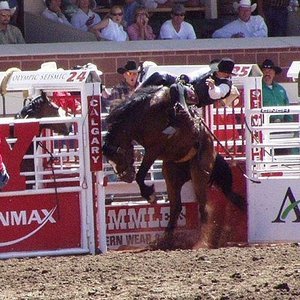
Bareback Riding
The most physically demanding event in a pro rodeo may be bareback riding. Cowboys use one hand to grasp a leather “rigging” to stay on the horse and are judged on their spurring technique and bucking action of the horse. To score higher points, riders must turn the toes of their boots outward and lean way back. No score will be given if the cowboy does not “mark out” the horse. Judges watch closely to ensure that as the horse comes out of the chute, the cowboy’s feet are above its shoulders. The feet must remain there until the horse’s front feet hit the ground. A bareback rider must remain on the animal for eight seconds.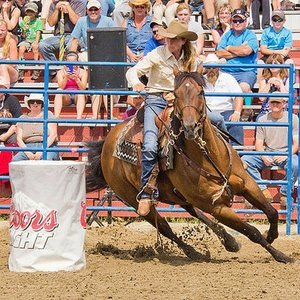
Barrel Racing
The goal of barrel racing is to run a cloverleaf pattern around three barrels in the fastest time. The horses pivot on their haunches at high speeds and execute each turn with only inches to spare. Normally, quarter horses are used in barrel racing. A knocked-over barrel incurs a five-second penalty.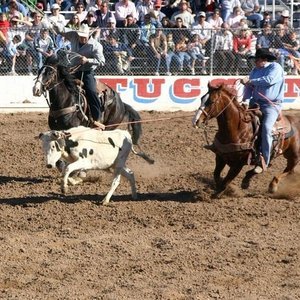
Team Roping
Team roping demands close cooperation between two cowboys (“header” and “heeler”) and their horses. The steer is given a head start as the header waits behind a rope barrier. If the header breaks the barrier, a 10-second penalty is assessed. The heeler follows. The header is the first one to rope and must catch the steer either around the horns, neck, or one horn and the head. As soon as the header secures the loop, he “dallies” the rope around the saddle horn and rides to the left, turning the steer away from a right-handed heeler. As the header rides away, the heeler tries to rope the steer’s hind feet. A five-second penalty is assessed if the heeler catches only one foot. The two riders then back their horses to take the slack out of their ropes. The clock stops when all the slack has been taken up and the ropers are facing one another.World Famous Suicide Race
In the old days, local Indians gathered at prime fishing sites during the salmon runs to harvest and dry a winter’s supply of fish. A favorite gathering place at the junction of the Sanpoil and Columbia rivers, eventually became the site of Old Keller. The people camped there in late May to fish and prepare for the festivities that always followed the completion of the salmon harvest. The celebration of the salmon is an ancient custom among the tribes of the Columbia Plateau that for centuries depended on the fish for sustenance. It was a time of work, but when the work was through and every person had a supply of dried salmon; it was a time of celebration and ceremony. It was a time of visiting with family and friends, feasting, dancing, and performing the traditional ceremonies that sustained the spiritual life of the people.
Horse racing was sure to be a component of any gathering of Native Americans. A festive parade displaying the horses flamboyantly decorated and in their finest trappings, preceded the races. During this display there was intense speculation and betting on the outcome of the race, with each tribe or band remaining loyal to their own horses. Erskine Wood, adjutant to General O. O. Howard, Colville Reservation. He recalled, “It did not take long for the excitement to grow and soon the bets were showering down and the pile swelling visibly with such great rapidity that is was marvelous how account could be kept. Blankets, furs, saddles, knives, traps, tobacco, beads, whips and a hundred other things were staked.” Though Wood’s visit was part of extensive government negotiations, the Indians still manages to run an average of one horse race per hour during the course of the meeting.
When the necessity of storing up dried salmon for winter was just a memory, the tradition of meeting to celebrate, renew friendships and race horses continued. In the 1920s Hugh McShane, a white man married to a Colville Indian woman named Sadie Nee, began promoting Salmon Days as the Keller Rodeo. In addition to roping and bronc and bull riding, McShane encouraged the continuation of a thrilling and dangerous race called the mountain race.
The mountain race was a holdover from the days when Indian men proved their skill and courage on horseback by competing in daring contests. The race was a half mile, pell-mell down a nearly vertical, boulder-strewn chasm in the face of a mountain. From there the riders raced across a dry channel of the Sanpoil River and charged into the rodeo arena. It soon became the crowd’s favorite event. Long-time Keller resident Henry Kuehne recalled that his parent’s horse, Diamond, a percheron-Hambletonian cross, won the race twice under the ridership of Tex Martin, a San Poil Indian who was a professional bronc rider of local notoriety. Kuehne further noted that original race was far more treacherous than anything seen in modern times, saying, “That old race could really be a horse killer. Compared to it, the race they have now is pretty tame.
The riders would start the tortuous climb up the mountain early in the day so they could rest their horses when they got to the top. Many a rider who climbed to the starting line failed to run in the race, losing nerve after a look down the steep mountainside. When the riders were given the go-ahead by the starter, veritable chaos ensued. The outcome of the race was often decided by who made it first to a narrow split in the fence of a rock ledge about halfway down the mountain. In the dash to get there first, there were terrible pileups. Kuehne remembered, “Sometimes you’d just see a huge cloud of dust when they got to that gap, and then would come some riders, and after that the guys who fell off would come rolling down the hill.” It was hard to tell if the many bandages and bruises seen around town at rodeo time were from the mountain race, rough stock events or the many brawls that erupted during the course of the rodeo.
Owners & Jockeys Committee
President
- Pete Palmer
Vice President
- Jonathan Abrahamson
Secretary
- Lea Cate
Treasurer
- Louie Leskinen
- Matthew Pakotas
- VJ Vargas
Indian Encampment & Pow Wow
Encampment Committee
President
-
- Flodell Williams
Vice President
-
- Hazel Hewankorn
Secretary
-
- Mandy McDonald
Treasurer
-
- Sam Wilson



